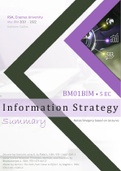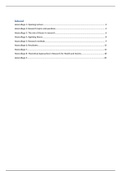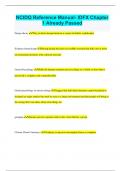Msc BIM 2021 - 2022
Kathleen Gaillot
BM01BIM • 5 EC
Information Strategy
Summary Notes/imagery based on lectures
Discovering Statistics using R. by Field A. ISBN: 978-1-4462-0045-2
Social Science Research: Principles, Methods, and Practices. by
1
Bhattacherjee A. ISBN: 978-1475146127
Mastering Metrics: The Path from Cause to Effect. by Angrist J. ISBN:
978-0-691-15284-4
, Table of Contents
Session 1: Digital Disruption ................................................ 1 6.2.1 How Amazon Finds Out Who the Customer is
1.1 Digital Technologies ............................................ 1 ............................................................................19
1.2 Understanding Industry Structure ...................... 2 6.3 Architecture .......................................................19
1.2.1 Value Chain ................................................. 2 6.4 Organization.......................................................20
1.3 Newly Vulnerable Market ................................... 2 Session 7: Digital Platforms................................................ 21
1.3.1 Criteria of Digital Disruption ....................... 3 5.1 Platform VS Product-Based Business Model .....21
1.4 Refresher: Porter’s Five Forces ........................... 3 5.1.1 Properties of a Platform ............................21
1.5 The Adoption of Digital Technologies ................. 4 5.2 Network Effects..................................................21
Session 2: Digital Business Models ...................................... 5 5.2.1 Four Types of Network Effects...................23
2.1 The Long Tail ....................................................... 5 5.3 Platform Pricing .................................................23
2.1 Disruptive Innovation .......................................... 5 5.3.1 Pricing the Platform ...................................24
2.1.1 The Disruptive Innovation Model ............... 5 5.4 Envelopment ......................................................25
2.1.2 The Three Waves of Innovation .................. 6 Session 8: Value of Information ......................................... 27
2.2 Digital Business Models....................................... 6 8.1 Big Data ..............................................................27
2.2.1 Digital Business Models .............................. 7 8.2 Experiment .........................................................28
2.2.2 Digital Competitive Advantage ................... 7 8.2.1 Correlation Vs Causality .............................28
Session 3: Information Goods ............................................. 8 8.3 Analytics .............................................................29
3.1 Information Goods .............................................. 8 8.3.1 Creating Value from Business Analytics.....29
3.1.1 Utility of Consuming Information Goods .... 8 8.3.2 Challenged in Creating Value from Business
3.2 The Physical Properties of Information Goods ... 8 Analytics ..............................................................29
3.2.1 Indestructability .......................................... 8 8.3.3 Analytics Strategy ......................................30
3.2.2 Transmutability ........................................... 9 8.4 Artificial Intelligence ..........................................30
3.2.3 Reproducibility ............................................ 9 8.4.1 History & Milestones .................................31
3.3 Information Goods’ Supply & Demand ............... 9 Session 9: Online Market ................................................... 32
3.4 Pricing of Information Goods ............................ 10 9.1 Transaction Costs ...............................................32
3.4.1 Price & Quantity Under a Monopoly ........ 10 9.1.1 Transaction Costs Composition .................32
3.4.2 Profit-Maximizing Under Competition ...... 10 9.1.2 Transaction Costs & Outsourcing in TCE....32
3.4.3 Profit-Maximizing Under a Monopoly ...... 11 9.2 Electronic Market Hypothesis ............................33
3.5 Differential Pricing: Three Types ....................... 11 9.2.1 Role of Asset Specificity & Product Desc.
3.5.1 Personalized Pricing .................................. 12 Complexity ..........................................................33
3.5.2 Group Pricing............................................. 12 9.3 Market Evolution ...............................................34
Session 4: Sana Commerce Guest Lecture ........................ 13 9.3.1 Risk Augmented Transaction Cost Trade Off34
4.1 Software Engineer: Demand vs Supply ............. 13 9.4 Information Asymmetry.....................................35
4.2 About B2B e-Commerce .................................... 13 9.4.1 Reducing Information Risk .........................35
4.3 Enterprise Resource Planning (ERP) Integrated E- 9.4.2 Incentive Theory ........................................36
Commerce ............................................................... 14 Session 10: Online Auctions ............................................... 38
Session 5: Versioning & Bundling ...................................... 15 10.1 Models of (Electronic) Markets .......................38
5.1 Versioning.......................................................... 15 10.1.1 Sales Auctions in Depths ..........................39
5.1.1 How Firms Actively Segment their Consumer 10.1.2 Double Auction Close-up .........................40
Base .................................................................... 15 10.2 Algorithmic bias ...............................................40
5.1.2 What to do as a Product Developer .......... 15 10.3 AI Ethics............................................................41
5.2 Bundling of Information Goods ......................... 16 10.3.1 Ethics: Moral Philosophy .........................42
5.2.1 Reasons for Bundling ................................ 16 10.3.2 Ethical Concerns of Algorithms ................43
5.2.2 Advantages of Bundling ............................ 16 10.3.3 Ethical Guideliens for Trustworthy AI ......43
5.2.3 Bundling strategy types............................. 16 10.3.4 Legislation: EU Artificial Intelligence Act .43
Session 6: Amazon Guest Lecture ..................................... 18 10.4 Explainable AI ...................................................44
6.1 Culture ............................................................... 18 10.4.1 Explanable AI = XAI ..................................44
6.2 Mechanisms ...................................................... 19 Examination Information: .................................................. 45
Sample Exam Questions...........................................45
Note: use CTRL + F for quick navigation / finding keywords.
Look for yellow stars in the left margin for topics that have been used in the exam in the past.
ii
, Learning Objectives
Analyse how the presence of IT enables new Explain how information products differ from Examine the key features of digital
business models and how digital disruption physical products; and apply theories of platforms; and explain the common
changes industry structure, and alter marketing, pricing, versioning and bundling of digital challenged and strategies in managing
sales, operations, and business practices goods to real-world examples them
Articulate the challenges and opportunities in managing Distinguish among different forms of online markets and online auctions;
data, information and AI strategies identify information-based problems in them and create solutions to solve them
Brief IS intro: Think about macro-trends; connectivity of devices, computing power, data. Some hyped-up ideas may
crash soon… what new technology is most interesting? Every business is an information business (said 20 yrs ago).
Session 1: Digital Disruption
Learning Goal: Define digital disruptions and analyze examples of digital disruptions.
1.1 Digital Technologies
How to evaluate the impacts of digital technologies on
industry dynamics?
SMACIT: Disruptive Technologies Social - Mobile - Analytics – Cloud - IoT
Social media Mobile Analytics (AI) Internet of Things (IoT)
Cognitive Computing Blockchain Biometrics
The disruptions keep evolving…
Gartner’s hype cycle: 5 phases
1. Innovation Trigger: A potential technology breakthrough kicks things
off. Early proof-of-concept stories and media interest trigger
significant publicity. Often no usable products exist and commercial
viability is unproven.
2. Peak of Inflated Expectations: Early publicity produces a number of
success stories — often accompanied by scores of failures. Some
companies take action; many do not.
3. Trough of Disillusionment: Interest wanes as experiments and
implementations fail to deliver. Producers of the technology shake out or fail. Investments continue only if the
surviving providers improve their products to the satisfaction of early adopters.
4. Slope of Enlightenment: More instances of how the technology can benefit the enterprise start to crystallize, and
become more widely understood. Second- and third-generation products appear from technology providers.
More enterprises fund pilots; conservative companies remain cautious.
5. Plateau of Productivity: Mainstream adoption starts to take off. Criteria for assessing provider viability are more
clearly defined. The technology's broad market applicability and relevance are clearly paying off.
Three trends in Emerging technologies’s Hype cycle:
1. AI everywhere (e.g. deep learning, machine learning, UAVs, autonomous vehicles)
2. Transparently immersive experiences (4D print, AR, connected homes, VR)
3. Digital platforms (5G, blockchain, IoT platform, quantum computing)
Digitized: Digitization Digital: Digital technologies are introducing speed and connectivity that they create
involves standardizing opportunities for entirely new customer value propositions
business processes. - Companies deliver digitally inspired customer value proposition in the form of digital offerings
Associated with cost cutting, - Digital offerings are information-enriched customer solutions delivered as seamless,
reliability, efficiency, and personalized customer experiences. Digital offerings introduce new business models and
transparency. provide new sources of revenue.
“The paradigm is not displacement and replacement but connectivity and recombination.”
1
, Some examples of digital disruptions:
o Entertainment (Blockbuster vs Netflix) o Photography (Kodak going bankrupt due to a lack of digitisation)
o o Telcom (nokia & blackberry) o Music (CDs vs on-demand. No more cassette) o Book (amazon…)
The process of digital disruption has to do:
1. Business world is increasingly digitizing
2. Breaking down industry barriers
3. Creating new opportunities while destroying long-successful business models
This process is called digital disruption
1.2 Understanding Industry Structure
Learning goal: Analyze how emerging technologies affect a given industry’s structure and dynamic.
Evaluate Digital Disruption: How does digital technologies change industry dynamics? Ask the following questions:
How can IT be used to reengineer core values activities and change the basis of the competition?
How can IT build or reduce barriers to entry?
How can IT add value to existing products and services or create new ones?
How can IT change the nature of relationships and the balance of power among buyers and suppliers?
How can IT increase or decrease switching costs?
1.2.1 Value Chain
A value chain is a set
of activities that
explains how a firm is
essentially configured
and linked, and the
way they are
organized. The way
they are configured
determines the
competitive advantage of
a given firm.
It can be used to analyse
internal operations and
evaluate key success and
key processes.
Support Activities Primary Activities
Firm infrastructure Inbound logistics
Human resources - Operations
technology development - Outbound logistics
- Procurement - Marketing & Sales
- After-sales services
1.3 Newly Vulnerable Market
Learning Goal: Explain why some markets are more
Why some industries are more vulnerable than others
vulnerable than others to be disrupted, and apply the in digital disruption?
conditions of the newly vulnerable market to an industry.
2











